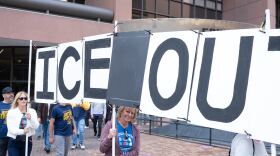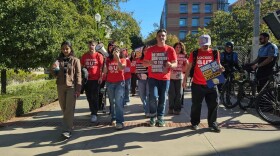Shortly after being sworn in for his second term, President Donald Trump declared a national emergency at the southern border, set plans in motion to deploy troops there and vowed — as he'd done repeatedly throughout his presidential campaign — to deport millions of people living in the U.S. without legal status.
Just days before the president's inauguration, KPBS spoke with local human rights advocates working in education, mental health, labor, and immigrant and refugee services, as they prepared for Trump to take office. They noted that media coverage of the southern border often falls short of helping the public understand the complexities of immigration.
Advocates highlighted two major misconceptions: the notion of an "invasion" at the southern border and the lack of understanding about the various ways immigrants can hold legal status within the U.S. immigration system.
Southern border 'invasion'
San Diego immigration attorney Ian Seruelo said that focusing news coverage solely on the southern border can be misleading.
“What is problematic is that the premise of the border policies is based on misinformation that there is an 'invasion,' and that those who are entering the southern border are criminals and terrorists. Hence, the solution is increased border security and more militarization,” Seruelo said.
Seruelo, who is also the chair of the San Diego Immigrant Rights Consortium, said this focus is false and dangerous.
“It creates a false narrative that the border region is a violent and criminal infested region, which is not the case," he said. "The southern border area is a binational region that has a rich history of shared community, trade and culture.”
Advocates point out that the focus is often on immigrants from Mexico and Latin America, but San Diego's immigrant community is far more diverse than what is typically represented in the media.
According to a report from the U.S. Immigration Policy Center at UC San Diego from 2020, in the city of San Diego, people born outside of the U.S. come from at least 115 countries and territories. The report also said Syria, Kenya, Sudan, Iraq and Nigeria represent some of the countries in the city with fastest growing foreign born populations. Additionally, the report projects that by 2030 a large number of the city's residents born outside of the U.S. will likely be from Asia, and the number of people coming from the continent of Africa will go past the number of people coming from Europe.
Immigrant ≠ 'illegal'
Another misconception immigration advocates highlighted is the belief that all immigrants are in the country without legal status. They said news stories about immigration often don't explain the different types of legal status people can obtain.
“The people showing up at the border are mostly asylum-seekers who are exercising their rights under U.S. and international law. The U.S. is a signatory to these many international instruments, and we have an obligation to provide an orderly and humane procedure to process their claims,” Seruelo explained.
Many immigrants, including refugees and asylum seekers, are eligible to be in the U.S. after submitting required documents and applications. They are known to the U.S. government and they have legal status. Throughout its history, the U.S. has set multiple immigration policies, classifications and statuses that grant permission to people from all over the world to be in the U.S.
Understanding immigration status
Here are a few of the different ways people can obtain permission to be in the U.S. Some of these statuses are currently changing under the new Trump administration.
U.S Citizen
A person who is a U.S citizen has permission to be in the U.S. They may have obtained their citizenship through birth or naturalization. This week a federal judge issued a ruling temporarily blocking President Trump's executive order that aimed to end birthright citizenship for children born to migrants in the U.S. temporarily or without legal status.
Lawful Permanent Resident (Green Card holder)
A lawful permanent resident is someone who has been granted permission to live in the country permanently. Sometimes this status is offered conditionally, for example this applies to people who immigrated to the U.S. as a spouse of a U.S. citizen; conditions can be removed after a few years.
Refugee or Asylee
A refugee or asylee is someone who has been granted permission to remain in the U.S. after seeking protection from persecution from the following: race, religion, nationality, membership in a particular social group or for their political opinions. Most recently, President Trump signed an executive order suspending refugee admissions effective Jan. 27, and the State Department confirmed the agency suspended refugee arrivals and would cease processing activities.
Asylum seeker
An asylum seeker is a person who is looking for safety and requesting protection. They are permitted to stay until their case is decided. According to U.S Citizenship and Immigration Services (USCIS), a person seeking asylum is someone who is physically present in the U.S. when applying, while a refugee is a person who requests permission to be in the U.S. from outside of the country.
Special Visas
There are different ways a person can be eligible for a special visa. For example, Iraqi and Afghan translators or interpreters who supported U.S. armed forces would typically qualify for this visa; it also applies to some religious workers, broadcasters and others.
Deferred Action for Early Childhood Arrivals (DACA)
This status provides legal protection from deportation to people who were brought into the U.S. as children. It is temporary and must be renewed. Since its implementation in 2012, this program has faced a series of legal challenges, the most recent this month. However, for now existing DACA recipients can continue to renew their deferred action and work authorizations.
Temporary Protected Status
People of certain countries may be eligible for Temporary Protected Status (TPS) if their country is facing armed conflict, natural disasters or other “extraordinary conditions.” The program provides a shield from deportation, a work permit and temporary legal status. As of this month, the following countries have that designation:









